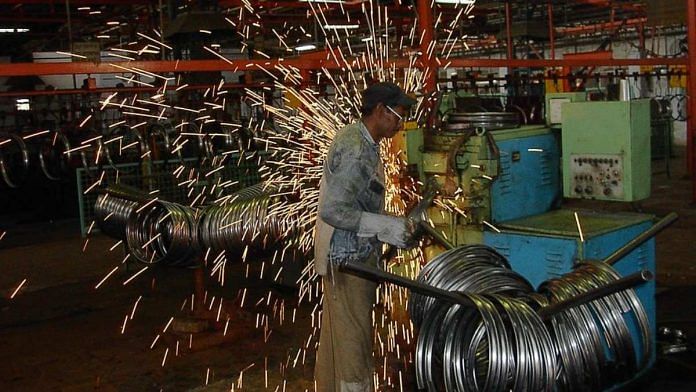New Delhi: India’s industrialists are tentatively reopening their factories, as the government eases the world’s biggest lockdown to revive an economy that was slowing even before the coronavirus outbreak.
Ajit Gupta, managing director of Ajit Industries Pvt., spent most of Monday supervising sanitization of his factory near the border of Delhi, which produces adhesive tapes used to insulate electric wires, package goods, or protect fridges and other electronics during transport. Printed signs at the gate urged staff to stay at least three feet from each other at all times and workers were hosed down with disinfectant after masked security guards took their temperature with thermal guns and handed out bottles of hand sanitizers. If even one employee tests positive for Covid-19, law mandates that the entire factory be shut for months.
“It’s very risky for us to restart business,” Gupta, 55, said by phone. “But the first quarter of this financial year will be washed out anyway and if the situation continues for a longer time, we may have to close down some operations.”
Following Monday’s partial lifting of the lockdown, Nomura Holdings Inc. estimates as much as 60% of India’s economy can now be open, but not before shrinking output by 0.4% for the year started April 1 compared with growth of 4.6% the previous year. One industry body predict labor shortages could last for as long as six months and as many as 40 million people may lose their jobs by September.
“India’s decision to partly relax the lockdown highlights the growing trade-off faced by developing countries of the economic costs of a lockdown versus health,” Nomura economists led by Sonal Varma wrote in a note. “Policies will need to be nimble because infection rates could resurge.”
Also read: How state govts are crowding out cash-strapped companies from debt market
Rural Exemptions
India has 17,615 confirmed cases, including 559 deaths. In an attempt to contain the outbreak, Prime Minister Narendra Modi doubled the duration of the initial 21-day lockdown but allowed farmers and certain industries outside virus hotspots to resume operations from Monday.
Companies that wish to restart however need to first get approval from local authorities, which is a tough task, according to Amritanshu Khaitan, managing director at Eveready Industries Ltd., the country’s biggest maker of flashlights and batteries. “Wherever we have got approvals, we are working with skeletal staff,” he said by phone.
The current fiscal year will also be a “litmus test” for Indian shadow lenders that depend on financial technology, according to the local unit of Fitch Ratings.
It estimates that such firms have total outstanding debt of about 30 billion rupees ($392 million), of which half is funded by banks and other lenders that may now hold back refinance. So-called non-bank financiers were allowed to resume operations in Mumbai on Monday, joining traditional banks that continued to function during the lockdown as they were classified as essential services.
‘Tough Situation’
“Immediate liquidity relief” from banks is a priority for Jindal Stainless Ltd., said managing director Abhyuday Jindal. India’s biggest stainless steel producer plans to gradually restart both its factories located in the states of Haryana and Odisha after it deals with issues including supply chain disruptions, congestion at ports and a labor shortage.
GAIL India Ltd. will start with some steps on Monday to return to normalcy once the lockdown lifts May 3, India’s biggest gas utility said in an emailed statement. Most of India’s automobile and phone manufacturers remained shut on Monday and will reopen later.
Indranil Pan, chief economist at IDFC First Bank Ltd., said firms will struggle to ramp up production to pre-lockdown levels. It’s very likely these companies, especially smaller units that employ the bulk of India’s workforce, will be forced to slash their staff, he said.
Risks also loom for Gupta, whose revenue was lower than target last financial year as India’s economy began slowing. He’s concerned about the future of his 500 employees, about 150 of whom were expected to turn up on Monday, some with pay cuts. Only about 75 showed up.
“It is a tough situation for us,” he said.-Bloomberg
Also read: HDFC Bank will withstand Covid-19 crisis better and outperform, experts say



